Journey of a Lifetime: Bike the Icefields Parkway
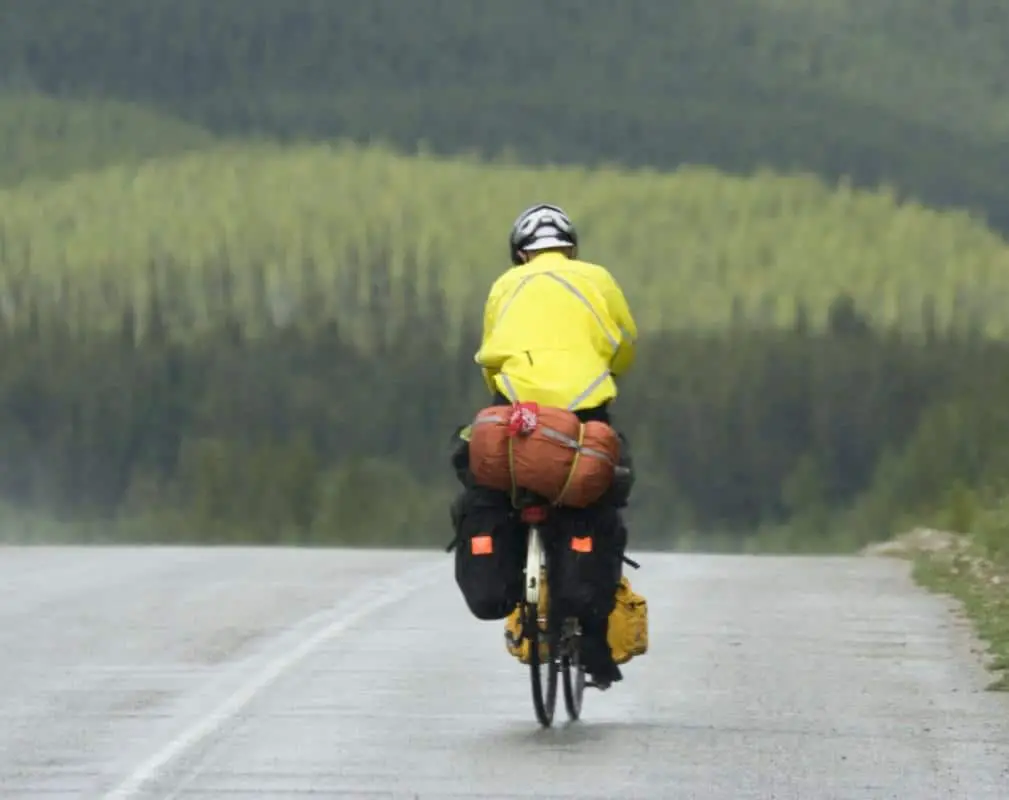
Why travel the Icefields Parkway by car when you can also traverse it by bike, right? The more adventurous among us understand that covering it by bike is much more spectacular and rewarding. But how to go about it and what are the challenges you’ll face on the way? You’ll find out in this post.
Cycling the Icefields Parkway is quite a mean feat at 230 kilometers (142.6 mi) of mountainous and rugged terrain. Mainly because you need to take camping equipment with you because it will take days to cover the entire distance.
Sure, pro cyclists in the Tour de France could cover the distance in similar circumstances in one day, but let’s be honest: You’re probably not as fit or as good. And what’s more: You wouldn’t want to cover it in one day. As a cyclist, you want the adventure, the excitement a journey like this has to offer.
That’s all nice and stuff, but you must prepare well. Without decent knowledge about your itinerary and proper equipment, you might end up in misery sooner or later.
If you want to read what the Icefields Parkway has to offer, I highly recommend you read the post The Ultimate Guide to the Icefields Parkway (Complete Overview).
How Many Days You Need to Cycle the Icefields Parkway?
The obvious answer to this question is: it depends. Assuming that you want to take your time to experience all the beauty the road offers (otherwise, you would have taken the car, right?), it’s wise to count in five to seven days.
Yes, you could probably do it in as little as two days, but that would mean you’re rushing it, so in that case: What’s the point of cycling the Icefields Parkway?
On the other hand: If you want, you could easily spend two weeks on the road, taking several days at each stop to explore the area.
Before you start your cycling journey, I’d recommend you plan your trip carefully. Cycling this stunning road takes time, so you must ensure you’ll be at your destination in time. This is especially true if you fly in and then have to take a flight home.
But also: What do you want to see? What hikes do you want to do, and how much time they’ll take you? Where and how do you want to spend the night? On a campground, in a hotel, or hostel? Also, take into account technical difficulties, your bike may unexpectedly break down, and you’ll need time to fix it.
What’s the Best Time to Cycle the Icefields Parkway?
The obvious answer is in summer, for obvious reasons. The weather is the best, especially for cyclists in mountainous areas. Summer can be pretty chilly, and the weather can change quickly. The other three seasons are simply too cold and/or too dangerous.
There will be too much snow on the road in winter, making for dangerous situations. The temperature will be far below zero. But okay, nobody in their right mind would attempt to cycle 230 kilometers in those circumstances, right? Right?

What’s the Roadway like?
The Icefields Parkway is a two-lane highway – one in each direction – with mostly wide shoulders on both sides. Be warned that some parts of the road have very narrow shoulders, so beware of cars, buses, trucks and RVs coming very close to you.
Luckily, the road’s surface is excellent, and so are the shoulders. Parks Canada maintains the route well, so there aren’t any treacherous stretches of asphalt. Maybe you’ll come across a pothole here and there, but these are exceptions.
Though watch out for the rims on the side of both lanes. They are there to warn drivers they’re leaving their lane, but if you ride onto it with your bike, it can be pretty unpleasant.
Alberta’s Cycling Traffic Rules
Traffic rules are the tedious part of cycling. They are good to know (well, at least some of them) when cycling the Icefields Parkway.
- The law states that cyclists and their passengers under 18 must wear an approved bicycle safety helmet (although it’s a good idea to wear a helmet regardless of age).
- Cyclists are required to ride as close to the right curb as possible. You may need to ride further out when avoiding drainage grates, potholes, trash, gravel or sand, wet or slippery surfaces, and rutted or grooved pavement.
- A bicycle, when being ridden, is regarded as a vehicle. A cyclist, like other drivers, must conform to road regulations.
- As a cyclist, you must equip your bicycle with at least one headlamp (but no more than two), one red tail lamp, and at least one red reflector installed on the back of the bicycle in case you want to ride after dark. Wear apparel that is bright and reflective.
How Dangerous Is Cycling on the Icefields Parkway?
It depends on how you look at it. You could reason it is. You’re cycling next to cars passing you at 90 kilometers per hour (55 mph) and sometimes even faster.
The good news: Canadian drivers (and Americans, too, for that matter) are pretty courteous when driving. So don’t expect the crazy driving you sometimes see in Europe or Asia. Besides, most people who drive the Icefields Parkway are not in a hurry and Canadians and Americans generally stick to the speed limit pretty well.
There’s one more thing you need to be aware of: cars parked on the shoulder of the highway. This happens when people spot wildlife nearby and get out of their cars to take pictures.
If you encounter a situation like this and don’t want to step off your bike, you’ll need to ride onto the driving lane for a couple of meters. Just be careful when doing this.
What Kind of Bike Is Best Suited to Riding the Icefields Parkway?
There are many types of bikes, like road bikes, mountain bikes, electric bikes, hybrid bikes, etc. You could argue that any of these bikes would suffice for your journey, but I recommend using a hybrid bike.
Hybrid bikes (also known as cross bikes) are similar to road bikes in terms of speed and ease of use while also being similar in terms of comfort and versatility to mountain bikes.
In general, if you’re cycling great distances, a road bike will get you faster from A to B. Hybrid bikes, on the other hand, are fully capable of traversing great distances and may be more comfortable.
As you cycle through rugged terrain, you probably expect a mountain bike to be the best choice to cycle the Icefields Parkway. This would be true if you would cycle off-road a lot. However, on the Icefields Parkway, you cover the entire distance on a paved road.
You’re more likely to hike when you leave the paved road, so you wouldn’t need your bike for this anyway.
What Gear to Bring on Your Journey?
Spending one or two weeks on the Icefields Parkway means you need to come prepared. You need to bring enough food and water, but there’s also a lot of gear you need to bring. Especially when you want to camp out at night.
Below I listed the essentials for your trip. If you don’t possess an item, you can easily buy it on Amazon, elsewhere online, or in your local store.
The items are linked to Amazon.com. Please note that if you decide to buy an item from this list through this website, I earn a commission at no extra cost to you.
- Panniers and bags (make sure you have enough space to store everything you need to take along)
- Helmet
- Repair kit, pump and spare tubes
- Gel bike seat cover or padded shorts
- Rechargeable bike lights
- Cycling gloves
- Bike tour clothing
- U-Lock to lock your bike
- A small waterproof tent
- Sleeping bag, Inflatable mat and pillow
- Portable Water Filter
- Microfiber towels & flip flops
- Waist Bag & Smartphone Holder
- Plug Adapter & Power Bank

Dealing with Technical Difficulties along the Way
When biking the Icefields Parkway, you need to be prepared for technical difficulties. If you can’t fix the problem, you’ll likely be stuck, which could pose unforeseen risks. So make sure you have the required technical knowledge of your bike before you head out.
The problem you’re most likely to encounter is a puncture. Learn how to repair it or know how to put on a new tube if the puncture is too severe for fixing. This ain’t difficult at all, you’ll manage easily.
Other repairs that require more knowledge and skill are fixing the brakes (essential!), fixing or even replacing the chain, and fixing your bike’s derailleur.
Several good websites teach you how to do it if you don’t already know. You can also ask someone in your surroundings who knows a thing or two about it
How Much Food and Drinks Do You Need to Bring along?
A thorough answer to this question could be a blog post in itself, but it would go too far to dive deep into this topic here. So below, you’ll find the essentials.
Regarding nutrition, the main question is: What should your caloric intake be when cycling, let’s say, 6 hours a day. To have a reasonable estimate, plan to consume 250 to 300 calories per hour of riding in addition to your average daily caloric intake of 1,500 calories (women) to 2,000 (men).
This way, you can calculate how much food you need to take with you. So three days out with 6 hours of moving time per day equates to carrying around 8,000 calories.
Aim for a well-balanced mix of nutrients. Carbohydrates for fuel, like rice, sweet potato, and porridge. Protein is required for both energy and muscle repair. Chicken, turkey, and venison are examples of lean meats.
Don’t forget about fat, an essential component of a balanced diet. It provides fuel, warmth, and other benefits. Nuts, seeds and oily seafood are also critical foods to take with you.
You can try rice, quinoa, couscous, or instant noodles as a meal base, then top with canned fish, cured pork, or pulses for protein and a stock cube, pesto, or a spice bag for flavor. Avoid foods that are easily damaged or perishable.
Bikepacking necessitates the same amount of water as any other outdoor physical exercise. In moderate weather, a usual guideline is to drink 1 liter of water every 2 hours of activity. But don’t go blindly by this advice. It’s just a guideline.
Maybe you’re a person who needs more water than others.
To ensure you’re carrying enough water with you, take a water bag of 15 to 20 liters, like a Camelbak-style pack. They come in various sizes, so choose according to your load requirements.
Where to Spend the Night on the Icefields Parkway?
You have several options for spending the night on the Icefields Parkway. There are six campgrounds along the way, all closely situated near the road. There are also four hostels and five hotels. You can check the post The Ultimate Guide to the Icefields Parkway to find out more about your options.
What to Do When You Come Across Wildlife on Your Way?
You will spend days riding along this road, so seeing wildlife is inevitable. Early in the morning, when wildlife activity is generally at its peak, you’ll probably continue traveling. Always maintain a safe distance between yourself and the animal, especially if there is a bear on the road. If you see one, stop and wait until it has crossed the street.
If you see wildlife later in the day, the many parked vehicles alongside the road will undoubtedly alert you about it.
Book an Icefields Parkway Cycling Tour
Don’t want to cycle the Icefields Parkway by yourself or with just the two of you? You can also do this amazing ride in groups by booking a tour! Rocky Mountain Cycle Tours has tours for a maximum group size of twelve people.
The trip takes six days and five nights, and you can start in either Banff or Jasper. Starting in either Banff or Jasper, the journey lasts six days and five nights. Naturally, this tour includes a knowledgeable guide, so you can be sure you’ll be safe and benefit from their experience and advice.
There are limited departure dates, so if you’re interested, make sure to book well in advance to guarantee your spot. You can find more information on their website.
Participation costs CAD 3,195 per person.
Cycling Distance Table Icefields Parkway
There are lots of places of interest along the Icefields Parkway. I’ve listed them below, ranging from highlights and viewpoints to restaurants, hotels and campsites. They are in order of appearance on the Icefields Parkway (or reverse order). I took Lake Louise Village as the starting point.
| Name | Kind of Stop | Distance from Lake Louise | Distance from Jasper |
|---|---|---|---|
| Herbert Lake | Highlight | 7.4 km (4.59 mi) | 226 km (140 mi) |
| Hector Lake | Highlight | 22.9 km (13.64 mi) | 211 km (131 mi) |
| Mosquito Creek Campground | Campground | 28.4 km (17.61 mi) | 205 km (127.1 mi) |
| Crowfoot Glacier Viewpoint | Viewpoint | 37.2 km (23.06 mi) | 196 km (121,52 mi) |
| Bow Lake | Highlight | 38.7 km (24 mi) | 195 km (121 mi) |
| Num-ti-Jah-Lodge | Hotel/Restaurant | 40.6 km (25.17 mi) | 194 km (120.28 mi) |
| Elkhorn Dining Room | Restaurant | 40.6 km (25.17 mi) | 194 km (120.28 mi) |
| Peyto Lake | Highlight | 45.5 km (28,21 mi) | 188 km (116.56 mi) |
| Silverhorn Creek Campground | Campground | 54.1 km, (33.54 mi) | 178 km (110.36 mi) |
| Waterfowl Lakes Campground | Campground | 61.3 km (38 mi) | 172 km (106.64 mi) |
| Waterfowl Lake | Viewpoint | 62.2 km (38.56 mi) | 171 km (106 mi) |
| Mistaya Canyon | Highlight | 75.1 km (46.56 mi) | 158 km (97.96 mi) |
| Saskatchewan River Crossing | Highlight | 80.4 km (49.84 mi) | 155 km (96.1 mi) |
| The Crossing Resort | Hotel | 81.1 km (50.28 mi) | 154 km (95.48 mi) |
| The Crossing Cafe | Cafetaria | 81.1 km (50.28 mi) | 154 km (95.48 mi) |
| Parkway Pub | Cafe | 81.1 km (50.28 mi) | 154 km (95.48 mi) |
| Mt Wilson Restaurant | Restaurant | 81.1 km (50.28 mi) | 154 km (95.48 mi) |
| Rampart Creek Campground | Campground | 93.2 km (57.78 mi) | 141 km (87.42 mi) |
| Weeping Wall Viewpoint | Viewpoint | 109 km (67,58 mi) | 125 km (77.5 mi) |
| Big Hill & Big Bend | Highlight | 116 km (71.92 mi) | 118 km (73.16 mi) |
| Parker Ridge | Highlight | 121 km (75 mi) | 113 km (70 mi) |
| Columbia Icefield | Highlight | 130 km (80.6 mi) | 104 km (64.48 mi) |
| Altitude | Restaurant | 130 km (80.6 mi) | 104 km (64.48 mi) |
| Chalet | Restaurant | 130 km (80.6 mi) | 104 km (64.48 mi) |
| Toe of the Glacier | Highlight | 130 km (80.6 mi) | 104 km (64.48 mi) |
| Glacier View Lodge | Hotel | 130 km (80.6 mi) | 104 km (64.48 mi) |
| Glacier Skywalk | Highlight | 136 km (84.32 mi) | 97.7 km (60.75 mi) |
| Tangle Creek Falls | Highlight | 137 km (84.94 mi) | 96.5 km (59.83 mi) |
| Hi Beauty Creek Wilderness Hostel | Hostel | 147 km (91.14 mi) | 86.3 km (53.5 mi) |
| Sunwapta Falls Rocky Mountain Lodge | Hotel | 178 km (110.36 mi) | 55.2 km (34.22 mi) |
| Sunwapta Falls | Highlight | 179 km (111 mi) | 54.2 km (33.6 mi) |
| Goats and Glaciers Lookout | Viewpoint | 195 km (120.9 mi) | 38.2 km (23,68 mi) |
| HI Athabasca Falls Wilderness Hostel | Hostel | 201 km (124.62 mi) | 32.9 km (20.40 mi) |
| Athabasca Falls | Highlight | 202 km (125.24 mi) | 32.4 km (20.08 mi) |
| Valley of the Five Lakes | Highlight | 223 km (138.26 mi) | 10.1 km (6.26 mi) |
| Becker’s Chalets | Hotel | 227 km (140.74 mi) | 7.1 km (4.40 mi) |
| Wapiti Campground | Campground | 228 km (141.36 mi) | 6.3 km (3.90 mi) |
| Jasper House Bungalows | Hotel | 229 km (142 mi) | 4.6 km (2.85 mi) |
| Whistlers Campground | Campground | 231 km (143.22 mi) | 4.2 km (2.60 mi) |
Want to read more about cycling in Banff National Park? I recommend reading the post Cycling in Banff and Lake Louise: All You Need to Know.

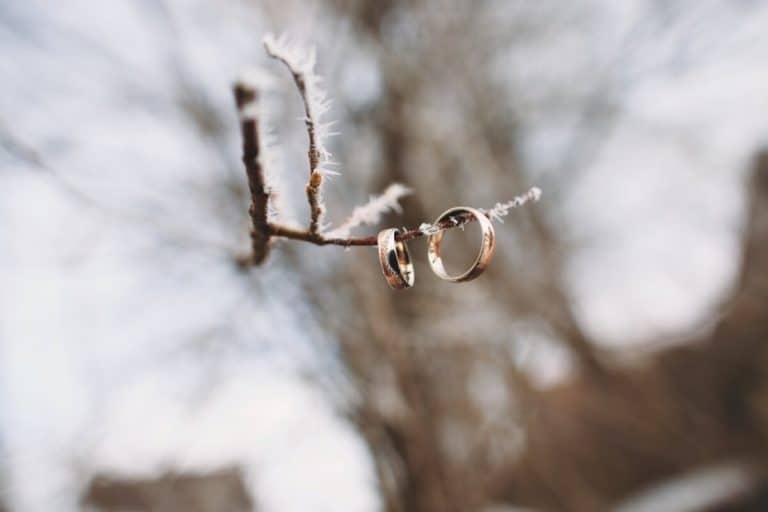
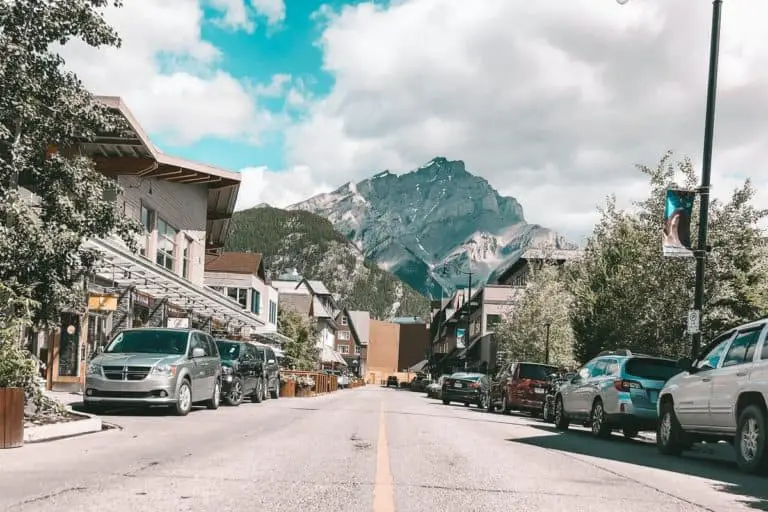
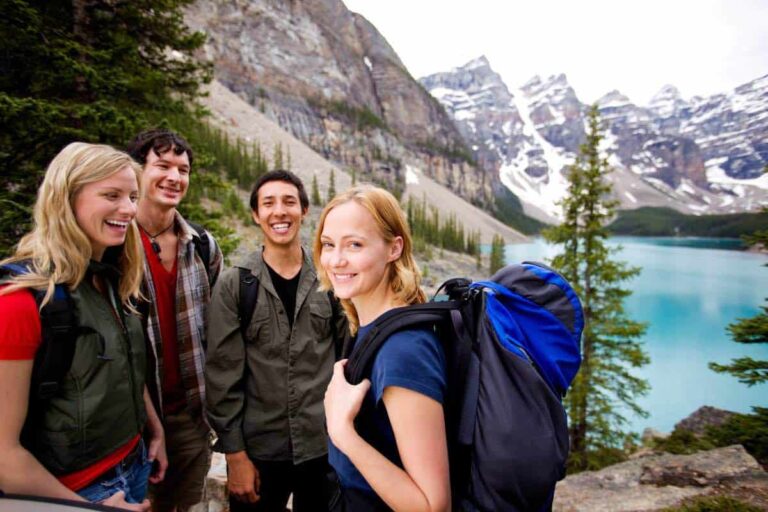
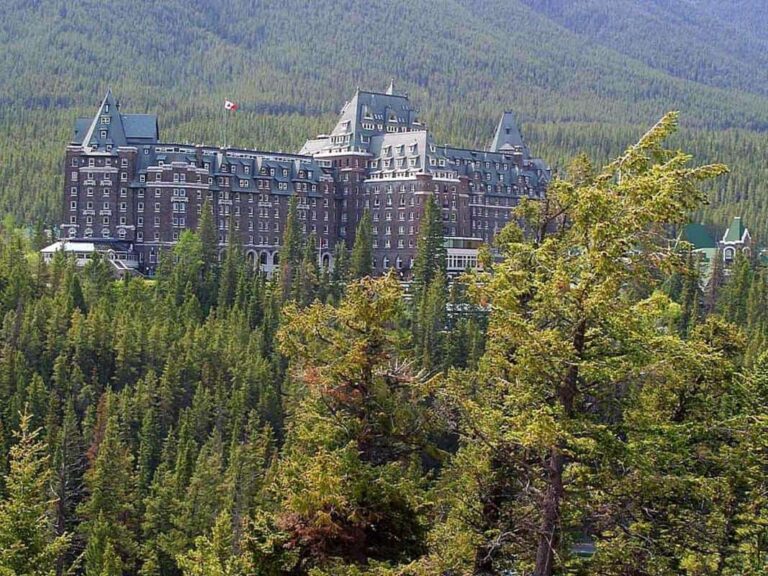
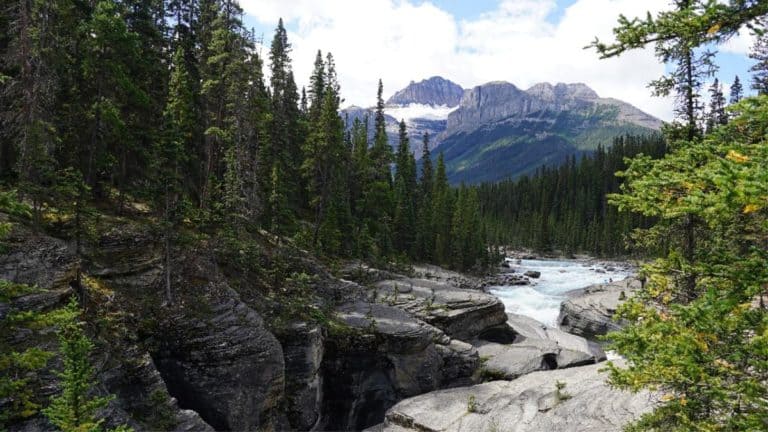

Thanks for sharing Dan. I plan in cycling the Icefields Parkway in August. Will a Gamin InReach mini be useful for the trip? I wany to have a way of getting in touch with my family. Thanks. Your post is very helpful.
Carmen
Hi Carmen,
The Garmin’s satellite connection will provide you with off-the-grid contact. So yes, you should be fine with it.
Enjoy your trip!
Dan
Where can one leave their car for the duration of the cycling trip if driving to the start?
Hi Jennifer,
That’s a good question. I’ve done some research to try and find an answer, but I haven’t found a clear one. Normally you can park on the grounds of a hotel, but if you’re not staying there, you probably can’t. Perhaps your hotel is willing to let you park your vehicle on their premises for a fixed price? Also, I know that the Banff Springs Hotel has a parkade where you can park your vehicle, even if you’re not staying at the hotel. However, this will cost you CAD 35 per night.
Dan